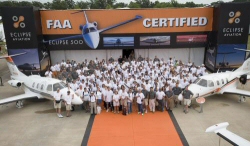AOPA Online Members Only -- Eclipse Marches Toward Certification, Provisionally
Eclipse Marches Toward Certification, Provisionally
| |
 |
Acknowledging the progress Eclipse Aviation has achieved in more than 1,400 tests encompassing in excess of 1,800 flights and 2,700 hours aloft, the FAA chose Oshkosh this year to announce issuance of a provisional type certificate for the Eclipse 500 very light jet. The Albuquerque-based manufacturer anticipates initial (non-provisional) certification for day/night/VFR/IFR single-pilot operations, including flight into RVSM airspace, by the end of August. Further approval for the aircraft will follow, with most of the advanced avionics features that define the Eclipse VLJ projected by the manufacturer to be available in October.
![]() Listen to Eclipse chief Vern Raburn talk at Oshkosh about the challenges of becoming an airplane manufacturer.
Listen to Eclipse chief Vern Raburn talk at Oshkosh about the challenges of becoming an airplane manufacturer.
While significant and indicative of progress toward the point where an aircraft transitions from promising design to functioning product, provisional certification in many ways is a certificate of convenience. Since a provisional certificate is indeed certification, albeit limited, the manufacturer benefits if its sales contracts state that certification triggers progress payments from customers. Eclipse will not take progress payments prior to receiving a full TC, according to an Eclipse spokesman. Some industry observers say a provisional TC benefits the FAA by demonstrating the agency's responsiveness to safety oversight in a timely manner. And fleet buyers may benefit from being able to use the aircraft for training and other aspects of operational testing prior to entering commercial service.
Commenting on what the provisional airworthiness certificate meant for the Eclipse 500, a spokesperson for the manufacturer said the FAA's issuance of provisional certification had many limitations, but it was an important step in achieving a full type certificate by the end of this month.
Provisional certification does not allow the aircraft to enter service with owners. Nor is it a production certificate that enables the manufacturer to build the aircraft without FAA oversight for each unit. Thus it is highly restricted and of marginal value other than as a sign of progress. While not typically the case in recent years, provisional certificates have been issued for aircraft that were months away from being commercially viable.
At Oskhosh, Eclipse President and CEO Vern Raburn acknowledged that his company agreed to several IOUs with the FAA, most but not all relating to achieving full functionality for the aircraft's avionics. Because the aircraft's avionics suite will lack the required TSOs for their installation in the Eclipse with its unique Avio system, the initial certification planned for late August will not include GPS navigation, flight management system (FMS) capability, or an electronic checklist. Eclipse will deliver the first few aircraft with Garmin 496 handheld units to provide operators with GPS functionality.
![]() Listen to Raburn talk about the strategy to go with a smaller jet.
Listen to Raburn talk about the strategy to go with a smaller jet.
Avionic features planned for approval by October include FMS, moving map capability, a third attitude heading reference system (three AHRS are required for commercial operations, such as DayJet's high-frequency service throughout the Southeast, scheduled to begin in mid-November), radar, full EFIS functionality, and several other items. Auto throttle operations are expected to be approved by March 2007. Raburn acknowledged, however, that many of the avionics items scheduled for October were not yet available, and none of the software for the items in question has been installed.
![]() Listen to Raburn talk about the owner/pilot market.
Listen to Raburn talk about the owner/pilot market.
Several other important flight test areas must be explored before certification is complete. The decision to fabricate the Model 500's tip tanks from aluminum and to increase their volume from seven to 19.5 gallons per side has necessitated a new look at the aircraft's flutter characteristics, which is a requirement whenever the wing's mass distribution is changed. Analysis as well as flight tests are required. Final tests for the structure's response to a lightning strike also wait installation of the new tip tanks. Larger tip tanks also will affect performance, as will the final software configuration of the aircraft's full authority digital engine controls (FADEC) that are an integral part of the Pratt & Whitney PWC 610 turbofans that power the Eclipse 500. Approval for flight into known icing has not been completed.
![]() Listen to Raburn talk about the changing owner/pilot paradigm.
Listen to Raburn talk about the changing owner/pilot paradigm.
No one said that obtaining a type certificate for the Eclipse would be an easy or swift task. To expect otherwise is fraught with unrealistic expectations. - John W. Olcott
The audio interviews were provided by Jason Paur.
Updated Thursday, August 10, 2006 4:15:16 PM


